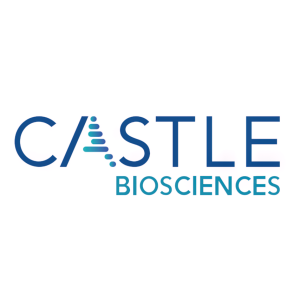TissueCypher® Outperforms Pathologist Diagnoses When Predicting Progression in Patients Diagnosed with Barrett’s Esophagus with Low-Grade Dysplasia
Castle Biosciences (NASDAQ: CSTL) announced new study findings showing that its TissueCypher® Barrett’s Esophagus test can accurately predict progression to high-grade dysplasia (HGD) and esophageal adenocarcinoma (EAC) in patients with Barrett’s esophagus (BE). The study involved 154 patients and found that TissueCypher surpassed standard pathology, accurately identifying 71% of those who progressed, compared to 63% by pathologists. The test may help standardize care plans and improve management decisions for BE patients, reducing risks of missed diagnoses.
- TissueCypher identified 71% of patients who progressed to HGD or EAC, outperforming pathologists' 63%.
- Test identified 43% of patients downstaged to non-dysplastic Barrett’s esophagus who later progressed.
- Study suggests TissueCypher can standardize patient management plans and improve risk stratification.
- None.
Insights
Analyzing...
New study data presented at Digestive Disease Week (DDW) 2022
In the study, TissueCypher outperformed standard of care in predicting malignant progression in a review of surveillance biopsies from 154 BE patients that were independently reviewed by 30 pathologists. Importantly, TissueCypher identified more than
Details of the study were shared in a podium presentation at Digestive Disease Week (DDW) 2022. The presentation was titled, “An Objective, Fully Automated Barrett’s Risk Prediction Assay Outperforms Pathology in Risk Stratifying Barrett’s Esophagus with Low-Grade Dysplasia.”
“There is extreme variability between pathologist observers in the diagnosis of BE, and a patient’s care plan and long-term outcome can vary widely depending on which pathologist provides the diagnosis. This is why the TissueCypher test has the potential to provide substantial value in the management of BE patients,” said Bergman. “As shown in the study, TissueCypher can improve the risk-stratification of patients with BE to more accurately identify those at highest risk for progression to esophageal cancer to ensure their management plans can be tailored appropriately with early and potentially life-saving interventions.”
The purpose of the study was to evaluate the predictive value of TissueCypher in 154 BE patients with a community-based diagnosis of LGD, and to benchmark the test’s performance against an international panel of 15 expert and 15 community-based, generalist pathologists. In the study, the panel of pathologists identified
Overall, the study demonstrated that TissueCypher can accurately predict progression to HGD or EAC in BE patients who are initially diagnosed with LGD, outperforming the majority of pathologist diagnoses evaluated in this study. Further, TissueCypher test results may provide an objective solution to observer variability, identifying more progressors early and helping to inform management decisions and standardize care plans for patients with BE.
About TissueCypher® Barrett’s Esophagus Test
The TissueCypher Barrett’s Esophagus test is Castle’s precision medicine test designed to predict future development of high-grade dysplasia (HGD) and/or esophageal cancer in patients with Barrett’s esophagus (BE). The TissueCypher Barrett’s Esophagus test is indicated for use in patients with endoscopic biopsy confirmed BE that is graded non-dysplastic (NDBE), indefinite for dysplasia (IND) or low-grade dysplasia (LGD); its clinical performance has been supported by nine peer-reviewed publications of BE progressor patients with leading clinical centers around the world. The test received Advanced Diagnostic Laboratory Test (ADLT) status from the
About
Castle’s current portfolio consists of tests for skin cancers, uveal melanoma, Barrett’s esophagus and mental health conditions. Additionally, the Company has active research and development programs for tests in other diseases with high clinical need, including its test in development to predict systemic therapy response in patients with moderate-to-severe psoriasis, atopic dermatitis and related conditions. To learn more, please visit www.CastleBiosciences.com and connect with us on LinkedIn, Facebook, Twitter and Instagram.
DecisionDx-Melanoma, DecisionDx-CMSeq, DecisionDx-SCC, myPath Melanoma, DecisionDx DiffDx-Melanoma, DecisionDx-UM, DecisionDx-PRAME, DecisionDx-UMSeq, TissueCypher and IDgenetix are trademarks of
Forward-Looking Statements
This press release contains forward-looking statements within the meaning of Section 27A of the Securities Act of 1933, as amended, and Section 21E of the Securities Exchange Act of 1934, as amended, which are subject to the “safe harbor” created by those sections. These forward-looking statements include, but are not limited to, statements concerning: TissueCypher’s potential to (i) provide substantial value in the management of BE patients and help inform management decisions and standardize care plans, (ii) improve the risk-stratification of BE patients by more accurately identifying those at highest risk for progression and predicting progression to HGD or EAC in BE patients who are initially diagnosed with LGD, (iii) provide automated and objective risk stratification with clinically impactful sensitivity, (iv) further inform patient management plans with clinically actionable and personalized information that could result in early and potentially life-saving interventions and (v) provide an objective solution to observer variability. The words “can,” “potential,” “could,” “may” and similar expressions are intended to identify forward-looking statements, although not all forward-looking statements contain these identifying words. We may not actually achieve the plans, intentions or expectations disclosed in our forward-looking statements, and you should not place undue reliance on our forward-looking statements. Actual results or events could differ materially from the plans, intentions and expectations disclosed in the forward-looking statements that we make. These forward-looking statements involve risks and uncertainties that could cause our actual results to differ materially from those in the forward-looking statements, including, without limitation: the effects of the COVID-19 pandemic on our business and our efforts to address its impact on our business; subsequent study or trial results and findings may contradict earlier study or trial results and findings, including with respect to the discussion of the TissueCypher® Barrett’s Esophagus test in this press release; actual application of our tests may not provide the aforementioned benefits to patients; and the risks set forth under the heading “Risk Factors” in our Quarterly Report on Form 10-Q for the three months ended
View source version on businesswire.com: https://www.businesswire.com/news/home/20220524006094/en/
Investor Contact:
czuckero@castlebiosciences.com
Media Contact:
amarshall@castlebiosciences.com
Source:







